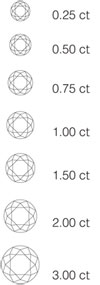SQUARE ONE – The Four C’s
The value of every diamond is determined by its ranking within in these four categories. During your analysis of the 4 C’s there are a few things to keep in mind; that every diamond is formed by nature and therefore unique, grading of diamonds is done by humans and therefore has room for debate, and within color and clarity there are ranges for each grade. When you add up all these variables, it means there are many ways in which someone selling a diamond can take advantage of a consumer. However, the smart, well advised consumer could use these variables to his/her advantage and get the very best value for the money spent.
Cut
This is the only one of the 4 C’s completely controlled by the hand of man. It is also the most important of the 4 C’s as it determines how light will move through the stone and therefore determine how “sparkly” your diamond will be. When comes down to it, for most diamond lovers it is all about the “sparkle” factor. Simply put, the better cut a diamond, the more it will sparkle.
The AGS and GIA laboratory reports currently grade the cut of the diamond as part of its overall evaluation.
0 Ideal Cut
1 Excellent
2 Very Good
3-4 Good
5-7 Fair
8-10 Poor
Excellent
Very Good
Good
Fair
Poor

Ideal Cut

Shallow Cut

Deep Cut
Carat Weight
Now, some diamond aficionados may argue that the hand of man also controls carat weight. True, up until a certain point – a diamond cutter can choose to cut a ½ carat diamond from a 2.90ct piece of rough or he could choose to cut a 1.00ct diamond from that same rough – however he cannot cut a 3.00ct diamond from that same 2.90ct piece of rough. So carat weight, in essence, is first controlled by nature. The carat weight of diamond is determined first by the size of rough you start with.
Diamond weight is measured on a scale of carats (ct), which is equal to 1/5 of a gram (0.20 grams). This is not to be confused with the Karat (kt) used in measuring the purity of gold. The carat scale of diamonds was originally devised by comparing the weight of a diamond against the weight of carob seeds (know in the ancient world for their consistency in shape, size and weight). In 1913 the United States officially adopted the metric carat.
Carat weight can be expressed in one of three ways; a decimal (the most common), fraction or a points scale
1.00ct = 1ct = 100 points
0.75ct = 3/4ct = 75 points
0.50ct = ½ ct = 50 points
0.25ct = 1/4ct = 25 points
1 point = 0.01ct diamond

Diamonds can be cut as small as 0.001ct. Any diamond ranging from the size of 0.001ct to 0.17ct are referred to, by people in the diamond industry, as melee. You may also have heard them referred to as diamond “chips” by friends or family.
Basically, the larger the diamond, the greater the carat weight, the more expensive the diamond. However the cost to carat weight ratio is not an equal one. A 0.50ct diamond does not cost half as much as a 1.00ct diamond. Following along that same line a 1.00ct diamond does not cost half as much as a 2.00ct diamond. The larger a diamond the more rare it is. The cost scale of diamonds is exponential like the Richter scale for earthquakes.
Color
Most consumers purchase some form of “white” diamond, graded on the standardize color scale which ranges from D (colorless) to Z (eye visible color).

Diamonds come in every color of the rainbow (blue, green, pink, orange etc.), these diamonds are referred to as fancy colored. Most diamonds contain some small amount of either yellow or brown; these diamonds must have a greater saturation of color to be considered “fancy.”
Diamonds are graded for color in laboratories under special lighting and in the table down position (as shown in the color scale). Diamonds are graded in the table down position to eliminate the “sparkle” factor – or the light return – which may influence color grading.
The most important thing to remember about color is that each grade represents a range of color.
The average consumer does not begin to notice color until the J range, particularly if the diamond is already mounted into a piece of jewelry.
Fancy color diamonds are very rare and there for are priced differently then diamonds graded on the D-Z color scale. Red is the most rare of all diamond colors. If you are interested in purchasing a fancy colored diamond I highly recommend the personal shopper service available through consulting.
Clarity
Since diamonds are a product of nature, the majority of diamonds contain some type of inclusion, unique identifying characteristic or “birthmark.” These inclusions can help to identify your diamond and make your diamond unique. There are a variety of diamond inclusions.
Diamonds are graded under 10 power magnification and fall into one of the following categories on the following scale:
Flawless – The diamond has no internal inclusions and is free from surface blemishes under 10 power magnification. Roughly 1% of all diamonds in the world are flawless.
Internally Flawless (IF) – the diamond has no internal inclusions but has some surface blemishes visible under 10 power magnification.
VVS1/ VVS2 – Very, Very Slightly included. The diamond contains very small inclusions visible under 10 power magnification. The diamond will appear to contain no inclusions when viewed with the unaided eye.
VS1/VS2 – Very Slightly included. The diamond contains small inclusions that are visible under 10 power magnification. The diamond will appear to contain no inclusions when viewed with the unaided eye.
SI1/SI2 – Slightly Included. The diamond contains inclusions that are easily visible with 10 power magnification. You may or may not be able to see inclusions with the unaided eye.
I1/I2/I3 – Included. These diamonds have larger inclusions which are eye visible without magnification.
The clarity grades of diamonds are determined in part by the type of inclusion and its location with in the stone. Since diamonds are created by nature no two diamonds are exactly the same. For example, there are some SI1 diamonds that look better than other SI1 diamonds due to the type of inclusion(s) and their location.
When buying a diamond it is recommended to view more than one before making your final decision.

